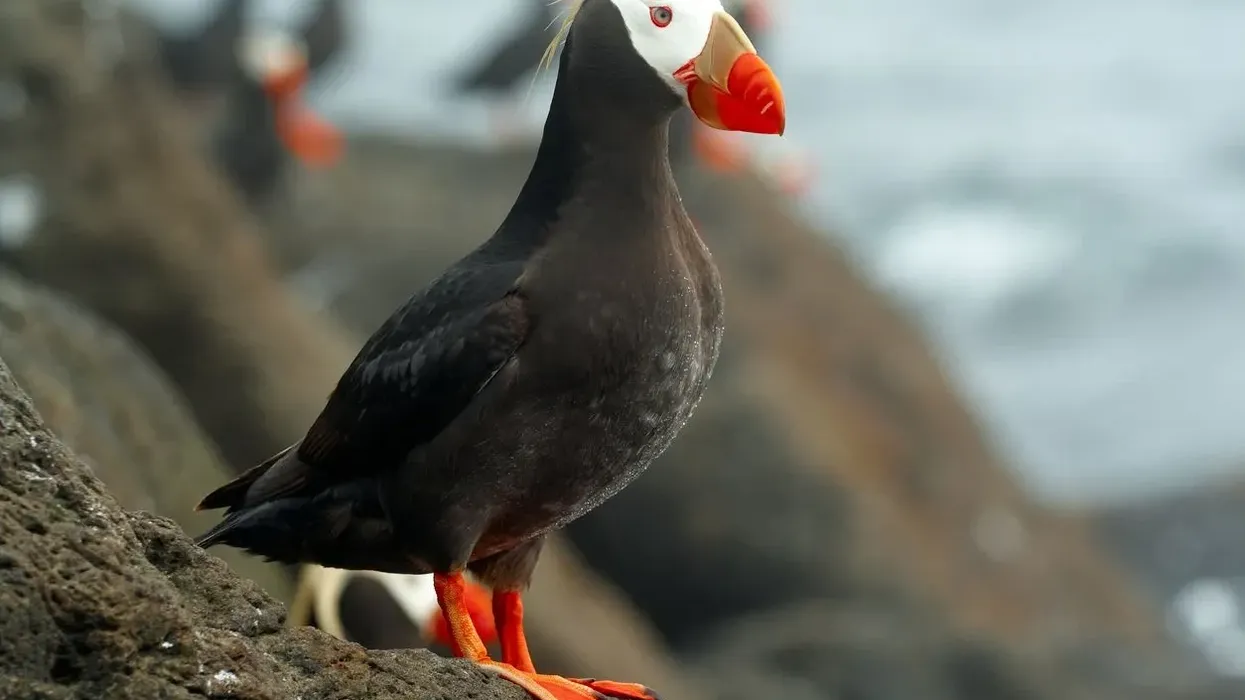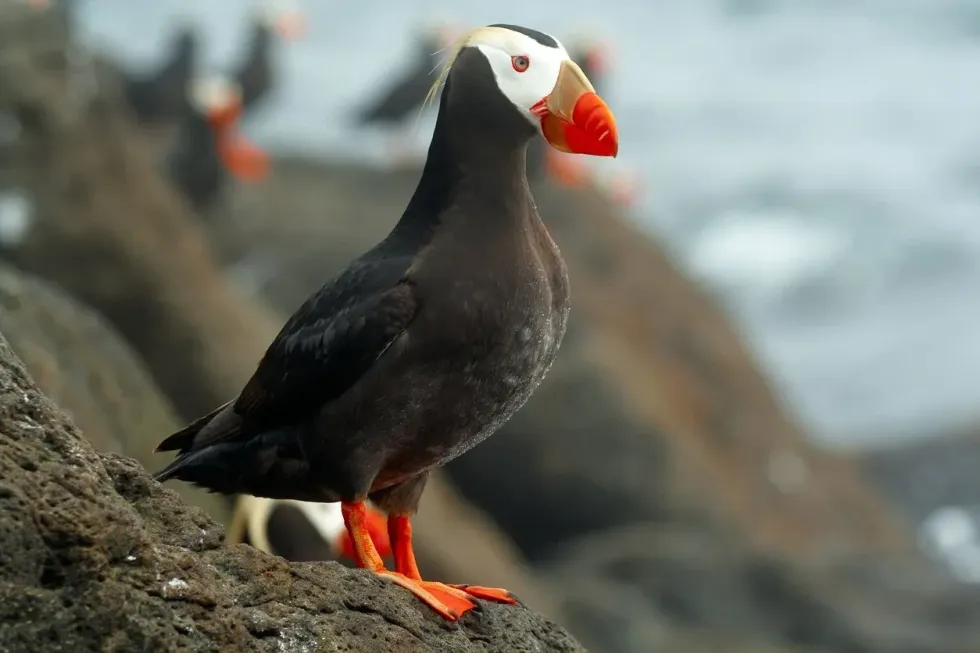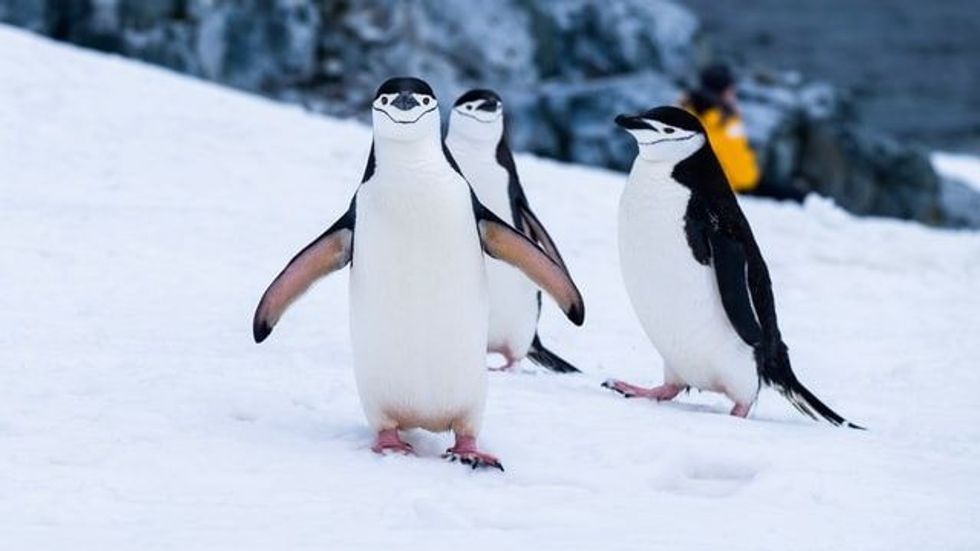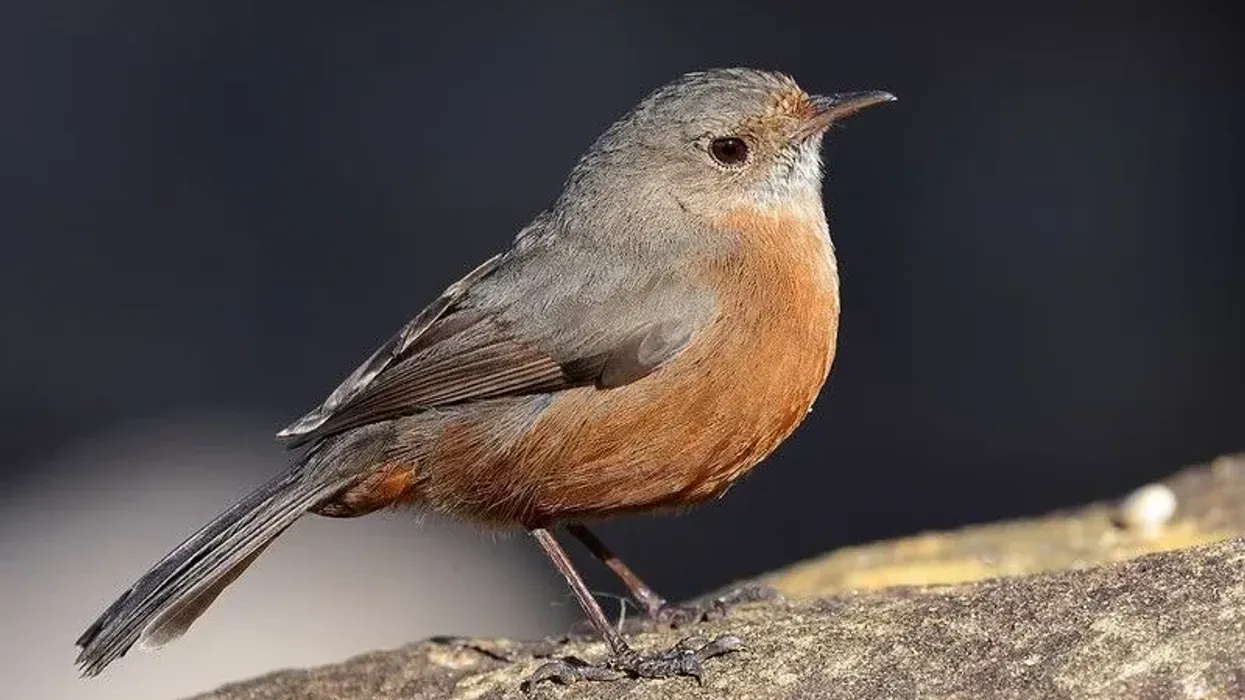The crested puffin or tufted puffin found in Northern Pacific and North American regions are seabirds that belong to the family Alcidae. They prefer living near the sea, looking for their primary diet, fish. Their waterproof feathers and short wings are used to dive underwater to catch fish to feed themselves and their young ones.
They prefer coastal regions near the sea, and during the breeding season, they search for grassy lands with soft soil and islands to dig a burrow and use as a nest site. They are social animals, and during the breeding season, they form large colonies and form burrows together to build a nest at a large site.
They are quite popular in North America. These seabirds can be seen in many states like Washington, Alaska, and California.
Females lay only one egg, and both parents take care of it. Upon hatching, they feed the young puffling. The typical tufted puffin's winter appearance is quite different from its summer appearance.
In winter, they are bright and intense colored and have bright red feet, and their bill is also bright-colored. As the winter leaves and summer enters, they lose their charm and become dull, and even their bills turn dull reddish-brown. The bright-colored feet remain the same, though.
Let's take a look at these tufted puffin bird's facts and information, and if you enjoy these then, do read about other bird species such as the rainbow lorikeet and American bittern for more amazing information.
Tufted Puffin Interesting Facts
What type of animal is a tufted puffin?
The tufted puffin is a species of bird found in the North Pacific region.
What class of animal does a tufted puffin belong to?
The tufted puffin (Fratercula cirrhata) belongs to the class of Aves, which means that they are a species of birds.
How many tufted puffins are there in the world?
There are approximately three million tufted puffins alive in the world right now, but according to recent reports, their population is declining.
Where does a tufted puffin live?
Tufted puffins are known to live near coastal regions, islands, and saltwater. They are a species of marine birds, so they prefer to live near the sea.
What is a tufted puffin's habitat?
The tufted puffin habitat includes saltwater, islands, and coastal regions near the sea. During the breeding season, they prefer places that have soft soil that allows them to dig a burrow for nesting.
Who do tufted puffins live with?
Tufted puffins are known to live in large groups and are even known to make breeding colonies during the breeding season. Approximately 25,000 pairs are recorded to be in a single colony.
How long does a tufted puffin live?
Tufted puffins can live up to 20 years in the wild. Tufted puffins take three to five years to become mature enough to perform breeding.
How do they reproduce?
Tufted puffins have large breeding colonies. They dig a burrow to perform the nesting.
Nesting sites may also change; they also make a nest on cliff tops or in crevices between rocks. The tufted puffin is also seen to perform billing with its mate during the breeding season.
They lay only one egg during the season, and it hatches in about 40-53 days, and parents take care of and feed the young one until it is ready to leave the nest.
What is their conservation status?
The status of conservation of tufted puffins (Fratercula cirrhata) is Least Concern as they are not under any major threat, and there are about three and a half million of them alive in the world.
Tufted Puffin Fun Facts
What do tufted puffins look like?
Tufted puffins have black-colored feathers on their body a white face and a yellow and orange-colored bill with some green-colored markings. The most distinctive feature of the tufted puffins is yellow-colored tufts which occur on a breeding adult. Their feet are also bright red.
Like any other puffin, tufted puffins have short wings which help them dive underwater and swim, and to catch a fish. Young puffins have a yellowish-brown bill. The males are slightly larger than the females.
How cute are they?
The tufted puffin is a cute and small bird. Their small size and rounded body make them lovable and attractive, and humans might find them cute because of it.
How do they communicate?
They make a low grumbling sound to communicate with each other, mainly in their nesting colonies in burrows. A tufted puffin call does not have a variety of notes and uses a limited number of sounds for communication. The young nestlings often use physical methods to indicate that they are hungry their parents, like peeping or making different postures.
How big is a tufted puffin?
Tufted puffin size is similar to a little crow; they are about 14-15 in (35- 38 cm) in length. They use their large bill to catch fish and carry a lot of small fish in their bills. Males are slightly larger than females.
How fast can a tufted puffin fly?
The tufted puffin's flying speed has been recorded to be 40 mph (64 kph) as they have really powerful wings and beats them around 300-400 times in a minute to achieve that speed. They are also great at swimming and use their ability to catch fish underwater.
How much does a tufted puffin weigh?
Even though these birds look puffy and heavy due to their feathers, they are lightweight. They only weigh around 24.67-29.6 oz (700-840 g), and if they were heavier, they would have difficulty in flying as, like any other puffin, tufted puffin also has short wings.
What are the male and female names of the species?
The tufted puffin genus species is Fratercula, which is a gender-neutral term for them. The male and female do not have any separate names, although you can differentiate between male and female as tufted puffin native males are a bit larger than females in size.
What would you call a baby tufted puffin?
A baby puffin is called a puffling, and tufted puffins are a species of puffins so their young ones can also be called pufflings. Young ones hatch after 40-53 days, and their parents feed them small fish and take care of them till they are mature enough to leave.
What do they eat?
Their primary diet includes fish; apart from fish, their food includes other sea animals like crab, octopus, and squid. The tufted puffin fish capacity is quite large; they can carry up to 12 fish crosswise in their bill in a single catch.
They are large and primary consumers of fish and eat them in large quantities and even feed them to little hatchlings who cannot leave the burrow.
Are they aggressive?
Tufted puffins are harmless to humans. They do not attack human beings unnecessarily. However, the situation might change if you try to invade their nesting sites. They have a really powerful bill and can easily penetrate your finger.
Would they make a good pet?
It is illegal to keep any tufted puffin pet in Canada and the United States as they come under the protected animal category. There are already only a few of them left in Washington.
Another reason to not keep tufted puffin (endangered) pets is that they are not suitable to be kept as pets inside the house. They drop feces wherever they want, and their main food is fish, so their feces smell like rotten fish, which is unbearable.
Did you know...
According to the tufted puffin taxonomy, their scientific name Fratercula cirrhata comes from Latin, where 'Fratercula' means black with white spots, and 'cirrhata' means curly-headed.
The tufted puffin range is widely spread. They are found in the North Pacific regions, Canada, British Columbia, Alaska, and Washington. Their habitat also includes coastal regions, islands, and cliffs. These act as suitable places for nesting and making burrows.
Another interesting fact about them is during the breeding season, the color of their bill becomes intense. Tufted puffins are most active during April to July as they are busy catching fish for the chicks that have hatched just now. They are quite similar to Atlantic puffins in their looks.
Their migratory pattern is still unknown, but during winters, they disappear from the ocean and seas as they freeze up, but it is still not confirmed whether they migrate or not.
They are known as crested puffins and are nicknamed 'clown of the sea' or 'sea parrot' because of their bright-colored bills. Tufted puffins have amazing diving ability.
They are known for holding their breath for a minute under the water and can carry a maximum of 60 fish in a single dive. They are seen catching fish crosswise (more than 12 fish) using their large bills. They are seabirds, so their diet primarily consists of small fish and crabs.
What color is the beak of a tufted puffin?
During the winter, their body becomes brighter and glossy. Their bills are bright yellowish-orange in color with green markings and bright red feet, but they lose their glow during the summer.
Their bills become dull reddish-brown, and their belly is also covered with brown-colored speckles. But, their feet remain bright red throughout the year, whether it is summer or winter.
How often does a tufted puffin flap its wings?
Tufted puffins have short wings, but they are powerful and help them in swimming and diving. They cannot, however, hover using these wings. They fly at high speed, up to 40 mph (64.3 kph), by flapping their winds around 300-400 times in a minute.
Here at Kidadl, we have carefully created lots of interesting family-friendly animal facts for everyone to discover! Learn more about some other birds from our flycatcher facts and stilt sandpiper facts pages.
You can even occupy yourself at home by coloring in one of our free printable tufted puffin coloring pages.










